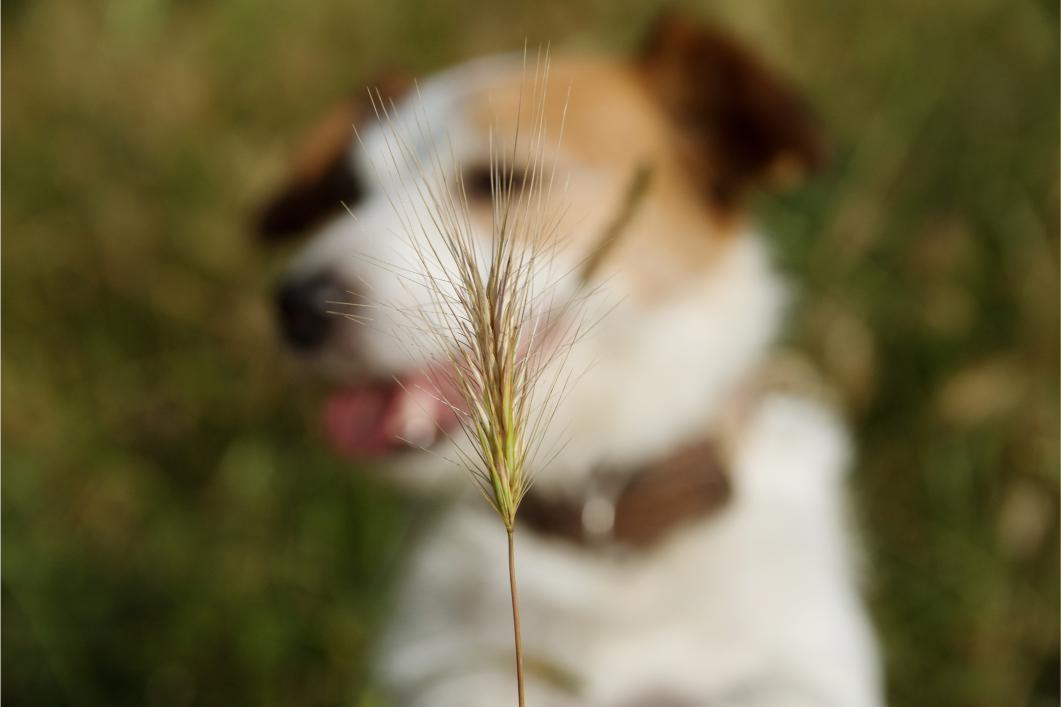Foxtail Plants — Summer’s Stealthy Danger to Dogs

Foxtail seeds have spread from their stronghold in the southwest to other parts of the country. This type of grass is commonly viewed as a weed, and its invasive nature doesn’t stop in the soil. From late spring and throughout the summer months, foxtails are a serious threat to dog health. If your dog loves to explore fields, meadows, parks, and hiking trails, it’s a good idea to know as much as possible about this plant.
Getting Specific
Because of their shape, size, and overall design, foxtails have the potential to pierce and burrow through skin and soft tissue. A type of grass awn, foxtails plants have backward-pointing barbs that are attached to long stems. To ensure they spread as far as they can, foxtails latch onto fur, fabric, and anything that moves by them. This means that an otherwise simple, innocent walk through a field can turn disastrous in no time.
Remaining Watchful
These seeds have a barbed and prickly awn that can burrow into the skin and potentially move throughout the body. An unnoticed foxtail may cause a skin infection or abscess that eventually leads to serious health problems such as a perforated lung or organ damage. Surgical intervention may be necessary to remove a foxtail.
What to Look For
Foxtails may be found between a dog’s toes, under their arms, in the ears, up the nose, around the mouth, and even on the eyelids. While it’s ideal to spot and remove them before they can cause any damage, many cases start when a dog suddenly develops a skin infection from an open wound. Foxtails that enter through the skin between the toes have the easiest time moving undetected. It’s best to inspect a dog’s feet after any time outside.
Scary and True
Foxtails can enter the lungs if a dog spends time sniffing the ground in foxtail-heavy areas. Inhaled foxtails can lead to constant sneezing, bloody discharge, and possible symptoms of pneumonia.
Signs of infection (open wound, pus) at the site are typical early warnings, but always be on the lookout for these signs of foxtail plants in dogs:
- Head shaking or tilting
- Scratching at the face, ears, nose, and mouth
- Pain, odor, and discharge from the ears, eyes, or nose
- Gagging or coughing
- Watery eyes
- Lumps or bumpy areas on or beneath the skin
Scan the Environment
You might not be able to totally avoid foxtails, but knowing where they grow adds an important layer of defense. Grass-covered trails, open or vacant lots, fence lines, ditches, and any overgrown areas may harbor dangerous amounts of foxtail plants that make it impossible to escape.
Keep your dog’s coat trim, clean, and free of tangles or mats. The hair between the toes should be carefully shortened. Always brush and examine your dog’s coat after any time in nature. If you see a foxtail on your dog, immediately remove it with tweezers or a brush. Watch for any problematic symptoms or changes to appearance and behavior.
Contact us right away at (330) 665-5915 with signs of infection, pain, or an embedded foxtail. We are always happy to help you at The Gentle Vet.
